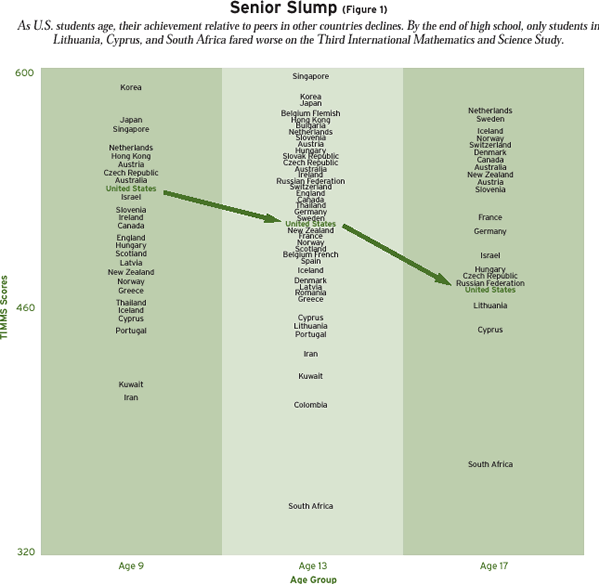 |
| Illustration by Tom Curry.
|
The early 1990s saw the height of the East Asian miracle. The economies of Japan, South Korea, Thailand, Malaysia, and other countries of the region were expanding at rates that dwarfed those of the United States and the mostly European nations of the Organization for Economic Cooperation and Development (OECD). The so-called “Asian tigers” were projected to surpass the U.S. economy in the not-so-distant future. In the national soul-searching that ensued, new attention was focused on the U.S. education system. Our poor academic performance vis-á-vis the countries of East Asia and indeed most of the developed world became a source of deep concern. The touchstone A Nation at Risk report expressed fear of a deteriorating education system leading to an erosion in our global standing. Thus many educators breathed a sigh of relief when the East Asian countries lost their luster. The U.S. economy entered a record-breaking period of high employment and recession-free growth during the 1990s, while Japan stagnated terribly-thereby validating, supposedly, our educational performance and approach.
Take testing critic Alfie Kohn, who writes, “As proof of the inadequacy of U.S. schools, many writers and public officials pointed to the sputtering condition of the U.S. economy. As far as I know, none of them subsequently apologized for offering a mistaken and unfair attack on our educational system once the economy recovered, nor did anyone credit teachers for the turnaround.” Or consider Gerald Bracey, a prominent defender of the public schools. Criticizing those before and after A Nation at Risk who have urged education reform in the interest of maintaining economic growth, he wrote in a recent Washington Post essay, “None of these fine gentlemen provided any data on the relationship between the economy’s health and the performance of schools. Our long economic boom suggests there isn’t one-or that our schools are better than the critics claim.”
Thus the sterling recent performance of the U.S. economy has become a convenient rhetorical tool for those who maintain that the education system isn’t in need of any serious reform. But these critics have woefully misunderstood the nature of economic growth and its link to educational performance. The confusion owes partly to the language and perspectives of the A Nation at Risk report itself. Written in 1983, on the heels of the stagflation of the 1970s and a recession caused by the Federal Reserve’s attempts to curb inflation, it implied that the current state of the economy could be traced directly to the performance of the education system.
Such a perspective fails to distinguish between economic growth and the business cycle. Economic growth is a long-term concept. It depends on past investments in physical capital, like industrial plants and machinery; human capital, the economist’s term for workers’ education and skills; and the pace of technological innovation. Now, growth may slow in the short term because of a downturn in the business cycle. But these short-term fluctuations in the unemployment rate, inflation, and economic growth from quarter to quarter or even year to year should not be confused with the economy’s ability to grow in the long term. And they certainly bear no relation to the current state of the education system.
That unemployment is lower on any given day in the United States than in Japan or Korea says virtually nothing about the relative quality of their schools. It might instead say something about the quality of current fiscal and monetary policies or about the extent of labor market and trade barriers across countries. It might even bear some relationship to the human capital investments made in past periods-when the current range of workers in the labor force was attending schools and investing in skills. Most workers in the economy were educated years and even decades in the past-and they are the ones that have the greatest impact on current levels of productivity and growth. Concerns about the current performance of U.S. schools reflect concerns about the potential for economic growth in the future-when today’s elementary, middle, and high schoolers become tomorrow’s engineers and scientists.
Skilled labor is becoming more and more valued in today’s economy. This is reflected in the compensation that skilled workers receive and the subsequent distribution of income in the economy. The gap between the skilled and the unskilled continues to grow. In turn, the economy’s long-term health is dependent on having a skilled labor force. The education system is central to the development of skills and human capital, a fact long recognized by parents, policymakers, and educators. During the past century, the United States led the world in the expansion of its education system, contributing to the dominant position of the United States in the world economy. Nonetheless, there is reason to be concerned about the future. The evidence suggests that the American K-12 education system is falling behind those of other developed nations. As a result, it is unclear whether we will be able to count on the education system to fuel future U.S. economic growth. As economic growth is crucial to our well-being, this is a matter we should take very seriously.
Human Capital and Economic Growth
Economic growth determines how much improvement will occur in a society’s overall standard of living. The effect of differences in growth rates on economic well-being is easy to see. If gross domestic product (GDP) per capita were to grow at 1 percent each year for 50 years, it would increase from $34,950 in 2000 to $57,480 in the year 2050-more than a 50 percent increase over the period. However, if it were to grow at 2 percent per year, it would reach $94,000 in 2050! Small differences in growth rates have huge implications for the income and wealth of society.
In turn, a society’s ability to develop human capital is crucial to its ability to grow. Human capital consists of the skills possessed by individuals and, in the aggregate, by the labor force as a whole. It is the result of a variety of investments made by individuals and institutions-in formal schooling, workplace training, life experience, and so on. In other words, formal schooling is not the only way to develop human capital-but it is a critical component. And schooling, as William Easterly emphasizes and I discuss below, is not sufficient to ensure growth, but it certainly plays a large role in a society like that of the United States, where the other preconditions for growth are in place.
Educational Quality
 |
| Concerns about the current performance of U.S. schools reflect concerns about the potential for economic growth in the future-when today’s elementary, middle, and high schoolers become tomorrow’s engineers and scientists. Photograph by Comstock Images.
|
Much of the early empirical work on human capital concentrated on the role of school attainment-that is, the quantity of schooling. This focus was natural. The revolution in the United States during the 20th century was universal schooling. Moreover, quantity of schooling is easily measured, and long-term data on years attained are readily available. Today, however, policy concerns revolve around quality issues much more than quantity issues. The completion rates for high school and college have been roughly constant for a quarter of a century. In addition, measures like completion rates and universal elementary education don’t say much about the kind of education that is being offered. Developing skills useful in the labor market and for economic growth requires rigorous training in high-quality schools. Schools that amount to no more than free day care or points of religious indoctrination won’t contribute to economic growth.
The current economic position of the United States is largely the result of its strong and steady growth during the 20th century. Strangely, in the period after World War II, economists did not pay as much attention to economic growth as they did to macroeconomic fluctuations in an attempt to tame the business cycle. In the past 15 years, economists have returned to questions of economic growth. A variety of models and ideas have been developed to explain differences in growth rates across countries; the importance of human capital is invariably a component.
The typical study finds that quantity of schooling is highly related to economic growth rates. But, again, quantity of schooling is a very crude measure of the knowledge and cognitive skills of people. It is unlikely that what is learned during the 6th grade in a rural hut in a developing country equals what is learned in an American 6th grade. Yet that is what empirical analyses implicitly assume when they focus exclusively on differences in average years of schooling across countries.
Recently, Dennis Kimko and I have delved into issues of educational quality. We incorporated the information developed during four decades of international testing on the varying mathematics and science performance of nations around the world. Our research has found a solid link between differences in school quality and differences in economic growth.
In 1963 and 1964, the International Association for the Evaluation of Education Achievement (IEA) administered the first of a series of mathematics tests to a voluntary group of countries. These assessments faced a number of challenges: developing a test that provided a fair comparison across countries with different school structures, curricula, and languages; creating comparable groups of testing participants across countries; and persuading countries to participate. The first tests did not document or even address these issues in any depth. However, these tests did prove that such testing was feasible and set in motion a process to expand and improve on the undertaking. Subsequent testing, sponsored by the IEA and others, has included both math and science and has expanded the group of countries tested. In each, the general model has been to develop a common assessment instrument for different age groups of students and to attempt to obtain a representative group of students taking the tests in each country.
Our analysis was very straightforward. We combined all of the available earlier test scores into a single composite measure of quality and introduced it into statistical models that explain differences in growth rates across nations during the period 1960 to 1990. (We excluded results from the 1995 Third International Math and Science Study and subsequent tests because they were obtained outside the analytical period of interest.) The underlying objective was to obtain a measure of quality for the labor force during the period for which we have measurements of economic growth. The basic statistical models, which include the level of income, the quantity of schooling, and population growth rates, explain a substantial portion of the variation in economic growth. Significantly, the quality of the labor force as measured by math and science scores proved to be extremely important.
Worldwide, we found that a difference in test performance of one standard deviation was related to a 1 percent difference in the annual growth rate of per-capita GDP. The impact of such a difference in growth rates is very large. As we saw earlier, 1 percent higher growth-say, growth of 2 percent versus 1 percent per year-over a 50-year period yields incomes that are 64 percent higher. Moreover, adjusting the data for other factors that are potentially related to growth, including aspects of international trade, private and public investment, and political instability, leaves the effect of having a quality labor force unchanged.
A common concern in analyses like this one is that schooling might not be the actual cause of growth but may just reflect other attributes of the economy that are beneficial to growth. For example, East Asian countries consistently score high on the international tests, and they also had extraordinarily high growth during the 1960 to 1990 period. It may be that other aspects of these East Asian economies have driven their growth and that the statistical analysis of labor-force quality is simply picking out these countries. But if the East Asian countries are excluded from the analysis, a strong-albeit slightly smaller-relationship is still observed between test performance and economic growth.
Another concern might be that other factors affecting growth, such as efficient market organizations, are also associated with efficient and productive schools-so that again the test measures are really a proxy for other attributes of the country. To investigate this, we concentrated on immigrants to the United States who received their education in their home countries. We found that immigrants who were schooled in countries that have higher scores on the international math and science examinations earn more in the United States. This analysis makes allowance for any differences in school attainment, experience in the labor market, or being a native English- language speaker. In other words, skill differences as measured by the international tests are clearly rewarded in the U.S. labor market, reinforcing the validity of the tests as a measure of individual skills and productivity.
Finally, the observed relationships could simply reflect reverse causality. In other words, countries that are growing rapidly have the resources to improve their schools. In this case, better student performance is the result of growth, not its cause. As a simple test of this, we investigated whether the international math and science test scores were systematically related to the resources devoted to the schools in the years before the tests. They were not. If anything, we found relatively better performance in those countries that spent less on their schools.
In sum, the relationship between math and science skills on the one hand and productivity and growth on the other comes through clearly when investigated in a systematic manner across countries. This finding underscores the importance of high-quality schooling to future well-being.
Explaining the U.S. Economy
 |
| Photograph by David Muir/Masterfile.
|
In this context, the United States presents a difficult conundrum. In the international exams of math and science that have taken place since 1970, the United States has been at best in the middle of the pack, at worst well below average. At the same time it has become the world’s economic superpower. How to reconcile these diverging trends?
The answer is that the quality of the labor force is just one aspect of the economy that contributes to economic growth. Expanding education in a developing economy, as Easterly argues, is unlikely to foster much growth if the economy fails to simultaneously acquire the market structures and legal and governance systems that are necessary for a high-performing economy. The United States has an abundance of these attributes, and they appear to compensate for the shortcomings of its education system.
Almost certainly the most important factor sustaining the growth of the U.S. economy is the openness and fluidity of its markets. The U.S. maintains generally freer labor and product markets than most countries in the world. The government generally lathers less regulation on firms, and trade unions are less powerful than those in many other countries. More broadly, the U.S. government intrudes less in the economy-not only with less regulation, but also with lower tax rates and minimal government production through nationalized industries. These factors encourage investment, permit the rapid development of new products, and allow U.S. workers to adjust to new opportunities. While identifying the precise importance of these factors is difficult, a variety of analyses suggest that such market differences could be very important explanations for differences in growth rates. These favorable institutional conditions have in some ways compensated for the deficits of our education system.
The United States has also been saved by the expansion of opportunities for higher education for its citizens. During the 20th century, the expansion of the education system in the United States outpaced the rest of the world. The United States pushed to open secondary schools to all citizens. With this also came a move to expand higher education with the development of land grant universities, the G.I. bill, and direct grants and loans to students. Compared with other nations of the world, the U.S. labor force has been better educated, even after accounting for the lesser achievement of its graduates. In other words, more schooling with less learning each year has yielded more human capital than found in other nations that have less schooling but where students learn more in each of those years.
This historical approach, however, appears on the verge of reaching its limits. Other nations of the world, both developed and developing, have rapidly expanded their schooling systems, and many now surpass the United States. In a comparison of secondary-school completion rates in 1999, the United States trailed a large number of other countries and fell just slightly below the OECD average completion rate. The United States gains some by having rates of college attendance above the typical OECD country. Nonetheless, U.S. students are not likely to complete more schooling than those in a significant number of other developed and developing countries. Thus, going into the future, the United States appears unlikely to continue dominating others in human capital unless it can improve on the quality dimension.
Still, it is not just college completion, but also the quality of the college experience that has been our saving grace. The analysis of growth rates across countries emphasized the quality of the elementary and secondary schools of the United States. It did not include any measures of the quality of U.S. colleges. By most evaluations, U.S. colleges and universities rank at the very top in the world. While there are no direct measures of the quality of colleges across countries, there is indirect evidence. Foreign students by all accounts are not tempted to emigrate to the United States to attend elementary and secondary schools-except perhaps if they see this as a way of gaining entry into the country. They do emigrate in large numbers to attend U.S. colleges and universities, however. They even tend to pay full, unsubsidized tuition at U.S. colleges, which a much smaller share of American citizens does.
A number of the economic models emphasize the importance of scientists and engineers as a key ingredient of growth. By these views, the technically trained college students who contribute to invention and to the development of new products provide a special element in the growth equation. Here again the United States appears to have the best programs. If this view is correct, U.S. higher education may continue to provide a noticeable advantage over other countries.
But the raw material for U.S. colleges is the graduates of our elementary and secondary schools. As has been noted frequently, the lack of preparation of our students necessitates extensive remedial education at the postsecondary level, detracting from the ability of colleges and universities to be most effective. On this count, there is yet another troubling aspect to U.S. academic performance. In international comparisons, U.S. students start out doing well in elementary grades and then fade by the end of high school. Figure 1 shows the slippage that occurs over time in comparison with other countries participating in the TIMSS math and science testing. To the extent that performance at the end of secondary schooling is most important-because it represents the skills students have as they enter college, because it sets the stage for science and engineering skills, or because it is important in its own right for workers in the labor force-schools in the United States are not keeping up with the preparation of students.

Source: Third International Mathematics and Science Study
Just a Jeremiad?
Observers like Bracey, Kohn, and others, dead set against any fundamental changes in the nation’s schools, usually work hard to dismiss the TIMSS results as evidence of any structural weakness in the U.S. education system. At least one objection they raise is interesting enough to consider. If innovation is key to economic growth, the argument goes, then an education system that encourages creativity and questioning rather than drill and memorization may give a nation a competitive advantage. This argument is usually trucked out as a defense against standardized testing, which is supposed to suppress our students’ natural curiosity. Bracey writes, “We should think more than twice before we tinker too much with an educational system that encourages questioning. We won’t benefit from one that idolizes high test scores. It could put our very competitiveness as a nation at risk.” However, none of these critics has ever produced any evidence that creativity is lessened when students improve their math and science skills. Nor do they speak to the costs placed on those individuals who neither reap rewards for exceptional creativity nor have the skills necessary to perform in the modern economy.
Bracey also suggests that we shouldn’t worry about the TIMSS results because they don’t seem to have any effect on our economic competitiveness. He cites as evidence the fact that a nation’s place on the Current Competitiveness Index developed by the World Economic Forum is not perfectly correlated with the TIMSS results, and the United States ranks high on the index. His explanation for our high ranking? All the reasons suggested above: the higher quantity of education in the United States, greater college attendance, retention of our scientists and engineers (while attracting foreign immigrants), and greater innovative capacity. It’s true that all of these factors have probably compensated for our educational deficiencies. But then just imagine how the U.S. economy might perform if its education system was top-notch! And what happens when we lose our advantage in any one of these factors-like when other nations create higher education systems like ours?
In February 1989, in an unprecedented meeting of the nation’s governors with President George H.W. Bush, an ambitious set of goals was set for America’s schools. One goal was that by the year 2000, “U.S. students will be first in the world in mathematics and science achievement.” By 1997, as it became evident that this goal wasn’t going to be met, President Clinton returned in his State of the Union speech to the old model of substituting quantity for quality: “We must make the 13th and 14th years of education-at least two years of college-just as universal in America by the 21st century as a high-school education is today.” It may make a better sound bite simply to offer two more years of schooling, but the best way to cement our competitiveness in the future is to ensure that every student gets a solid education during the first 12 years of school life.
-Eric Hanushek is a senior fellow at the Hoover Institution, Stanford University.


